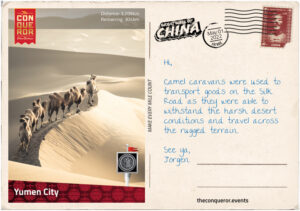När det endast återstår 304 km, alltså 3 209 km avverkade, kom det tjugosjunde vykortet.

Tjugosjunde vykortet
Located west of the Hexi Corridor on the edge of Gobi Desert is the small city of Yumen. Today it is an industrial city, primarily focused on oil drilling, wind power-generation and large-scale factories. However, 2,100 years ago, when it came under Han Dynasty control, it was a thoroughfare for merchants, warriors, diplomats and missionaries to trade goods and exchange knowledge, technology and religious beliefs.
This ancient trade route, along with several others, made up the renowned Silk Road. This overland route began in the city of Xi’an, then travelled along the northwest section of the Great Wall, over the Pamir Mountains, through Afghanistan and to the Mediterranean Sea where the goods were shipped to Europe.
At 4,000mi (6,400km) in length, the Silk Road was a melting pot of cultures and ethnic diversity. Very few people travelled it in its entirety, giving rise to a number of middlemen and trading posts along the way. Bandits were a major threat to travellers. To protect themselves, they would often join together in caravans and over time, inns to accommodate them cropped up.
Silk was one of the major goods exported by China to the west, hence the name Silk Road. Production of silk was a closely guarded secret in China and the fabric was highly prized by the Roman elite. Being of high value but low weight, silk was an ideal product to carry on long distances. Other significant items used for trade were: horses, jade, paper, spices, glassware, furs and unfortunately also slaves.
Marco Polo was one of the first Europeans to travel to China via the Silk Road. He was 17 years old when he embarked on a journey with his father to the far east. Leaving Italy by ship, they sailed to Acre, in modern-day Israel and then travelled by camel to Persia (present-day Iran) where they planned to sail straight into China. The ships, however, were not seaworthy and so they decided to continue overland through the Silk Road. During their trip, the Polos joined a travelling caravan that was soon ambushed by bandits who used a sandstorm as cover. They were fortunate to escape through a nearby town but sadly many of the caravan members were killed or enslaved. It took the Polos three years to reach Kublai Khan’s summer palace in Shangdu, China.
Trade on the Silk Road came to an end in the 15th century when transportation shifted to the sea, this became known as the Maritime Silk Road. The ability to carry more goods at a cheaper price marked the decline of the overland route.
The Silk Road could be seen as an early example of globalisation. It connected the Orient to Europe through trade and cultural exchange and at its end it inspired Europeans to cross the ocean and explore the New World (the Americas).